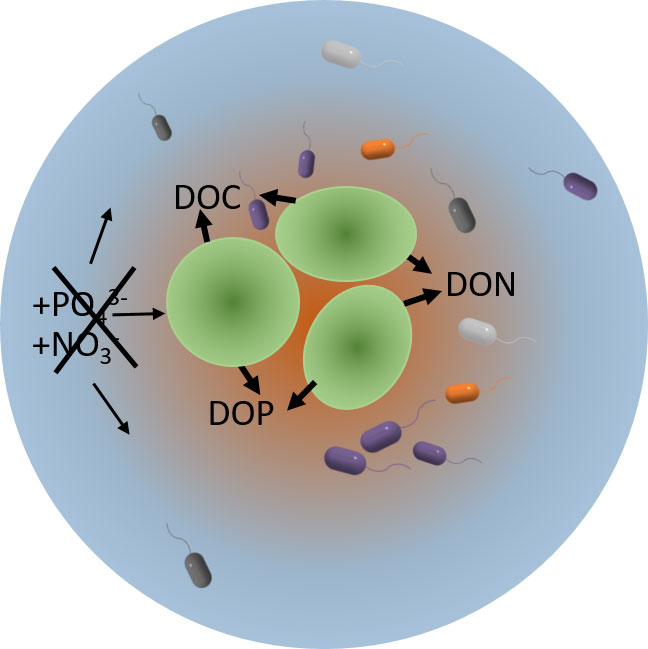Net primary production in oligotrophic oceans alone is comparable to that of all the world’s tropical rainforests. The cyanobacterium Prochlorococcus acts as one of the most important primary producers in the ocean and releases huge amounts of organic compounds - so called exudates - into the surrounding waters that can act as nitrogen, carbon and phosphorous sources for bacteria. Yet, surprisingly little is known about the relevance of this process. Specifically, the significance of organic nutrients provided with phytoplankton exudates in relation to inorganic forms dissolved in the water column remains to be explored for bacteria.

Figure: Schematic of phytoplankton-bacteria interactions with dissolved organic matter (DOM, orange zone) exuded from phytoplankton like Prochlorococcus (green balls) and taken up by bacteria (spherical cylinders). The exuded DOM contains DOC, DON and DOP and nourishes bacteria with all necessary components so that inorganic nutrients like nitrate and phosphate seem less important for marine bacteria.
We have experimentally investigated the role of Prochlorococcus as a carbon and nutrient source for the accompanying bacterial community in the Mediterranean using isotopically labeled dissolved organic matter (DOM) of cultured Prochlorococcus. We also added inorganic nutrients in different set-ups to compare the role of the exudates’ organic vs. inorganic nutrients. Using highly advanced methods like NanoSIMS, the isotope ratio could be analyzed on a nanoscale for the determination of bacterial uptake of labeled organic compounds at the single-cell level. Together with the analysis of the bacterial community structure using molecular tools like 16S rRNA amplicon sequencing this allowed us to generate a comprehensive view on phytoplankton-bacteria interactions. Our outcomes strongly indicate that phytoplankton exudates provide organic carbon, nitrogen and phosphorus to bacterial communities in coastal as well as open-ocean environments and fully satisfy the carbon, phosphorus and nitrogen demands of >50% of the bacterial community in the very nutrient-poor eastern Mediterranean.
Oligotrophication is known as one possible scenario resulting from rising temperatures and subsequently a more stable stratification in the global ocean. This will lead to an increasing starvation of entire plankton communities including phytoplankton and bacteria and, thus, to large shifts in oceanic cycling and storage of carbon. To better understand these processes, which are largely based on the interdependence of phytoplankton and bacteria interactions, it is important to elucidate bacterial uptake of exudates and inorganic substances delivered by major phytoplankton such as Prochlorococcus. Understanding the adaptive processes of the oceans’ plankton communities, especially of Prochlorococcus-associated bacterial communities, allows to better project functional changes at the base of the oceanic food web related to global change including warming and anthropogenic impacts.
This study exemplifies how closely phytoplankton species are linked to bacteria through the release of exudates satisfying their metabolic functions. Changes in plankton communities due to external forces potentially disrupt these relationships and affect oceanic productivity. Knowing the underlying mechanisms, thus, allows to better project future consequences, e.g., in terms of carbon cycling.
|
HFSP award information Research Grant - Program (RGP0020/2016): Interactions among marine microbes as they grow and die: linking experiments and genome-scale models Principal investigator: Hans-Peter Grossart, Leibniz-Institute of Freshwater Ecology and Inland Fisheries, Stechlin, Germany |


































